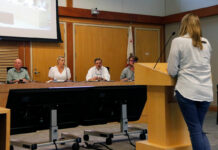Last week’s rains lived up to their advanced billing. All parts of Sonoma County got a real soaking from a bona fide Pacific storm, the kind of blowing and hard downpours that have always marked our northern California winters. The average annual rainfall over our Russian River basin is about 45 inches. Our most recent storm brought us a good percentage of that total in just 48 hours. But we know that our weather is anything but “average.”
That is how we come to live under two emergency declarations at the same time. We still have a federal drought emergency in place from three years of record low rain totals. And, after the skies unleashed six inches of rain in one night, parts of our county are being declared local storm emergencies too.
Billions of gallons of water, gathered by warming air over the cool Pacific, were dumped on our homes and heads last week as the storm door to the Pineapple Express was blown wide open. Most of that water continues to flow back to the ocean, overflowing the banks of small streams and the Russian River.
But, unlike past storm episodes, more rain water than ever was captured in manmade reservoirs. Local farmers’ erosion-protection barriers could be seen at work, keeping soils and debris out of streams and slowing drainage to better feed underground acquifirs.
School children and farmers treated the rains like an early Christmas present. But not everyone felt blessed by the big storm. Healdsburg merchants and other businesses were soaked, damaged or interrupted by the rising waters. Thousands of rural neighbors lost electric power and had to detour around dozens of flooded roads.
The return of a real winter storm helped separate our newer residents from those who claim to be “veterans” of the big floods of 1986, 1995 and 2006. The old-timers were the ones with sand bags, water bottles, flashlights and batteries. Newcomers were the ones who marveled at the alarming pace of the river’s rising under the bridge crossings at Cloverdale, Healdsburg, Hacienda and Jenner. Newcomers may have been the ones seen in news photographs, sitting forlornly atop their flooded and stranded cars.
There was the return of the “media circus” with TV satellite trucks and camera-toting newsmen, reporting from the usual flood-time landmarks in Guerneville and Monte Rio. Floods are more exciting to cover than droughts, apparently.
Schools closed ahead of the storm, an unusual, but smart move on the part of administrators. Some of the students used their free day kayaking in swampy backyards and temporary lakes. The Laguna de Santa Rosa, after troubling years of brown foliage and bare mud, looked like it should in the middle of December. Ducks and geese approved.
But as soon as the rains slowed and the Russian River dropped back inside its crooked channel, drought reminders were being broadcast again.
The parched reservoirs all over the Bay Area region, North Coast and Sacramento-San Joaquin Delta — including our Lake Sonoma and Lake Mendocino — still remain at record low levels. In this year alone, from now through April, it will take seven more storms like last week’s to equal a year of average rainfall. And, then after two more years of the same storm totals, we might finally escape our declaration of drought.
One thing is for sure; we cannot count on our rains or weather being “average.” We will have to take some flooding along with the good impacts of living in the path of the Pacific’s Pineapple Express. For those businesses or individuals with recent storm losses, this is not a comforting reminder. But it is what we have to expect — and prepare for— when you live in a place where 90 percent of our annual rain falls in just a few months of every year.
As it turns out, praying for rain is complicated.
— Rollie Atkinson








